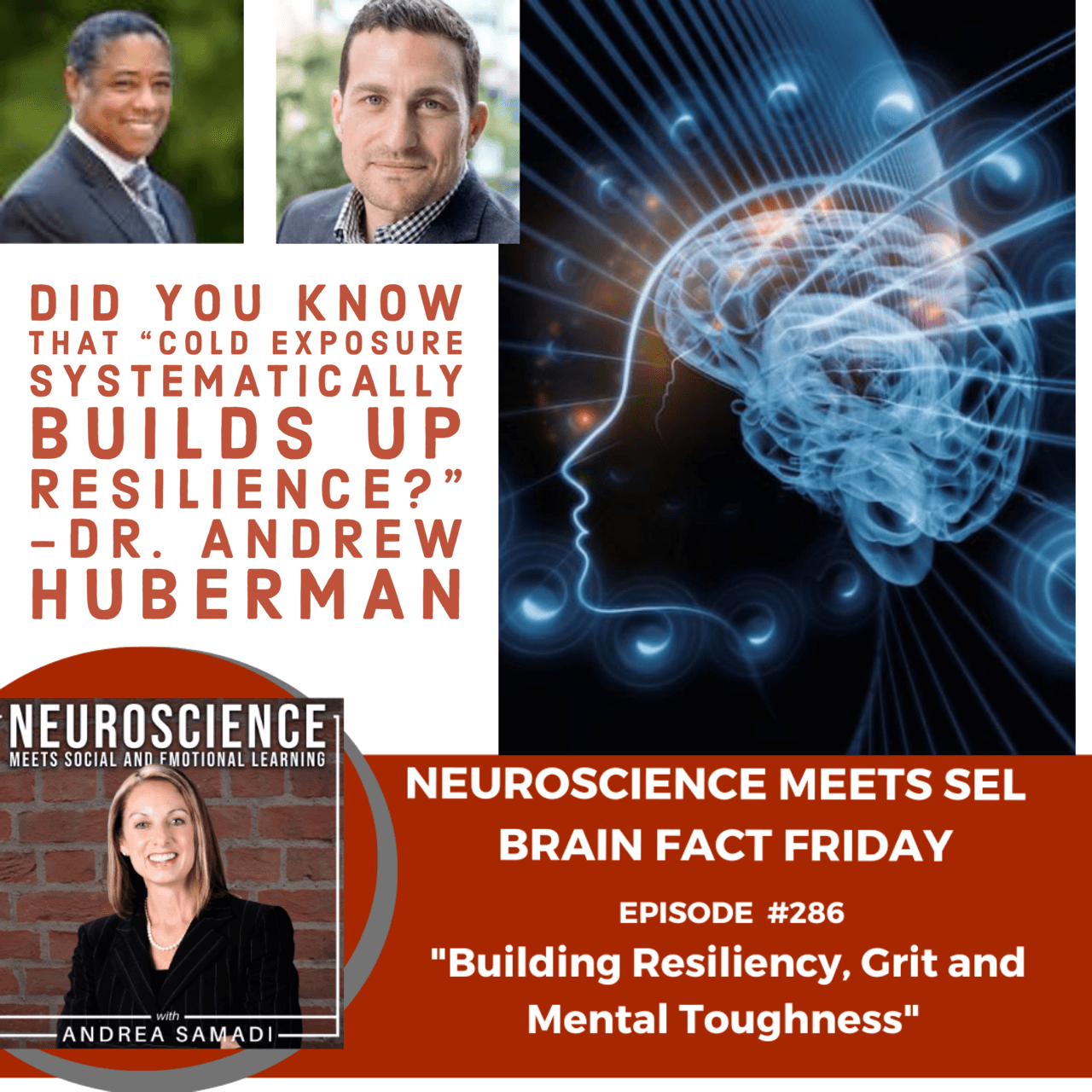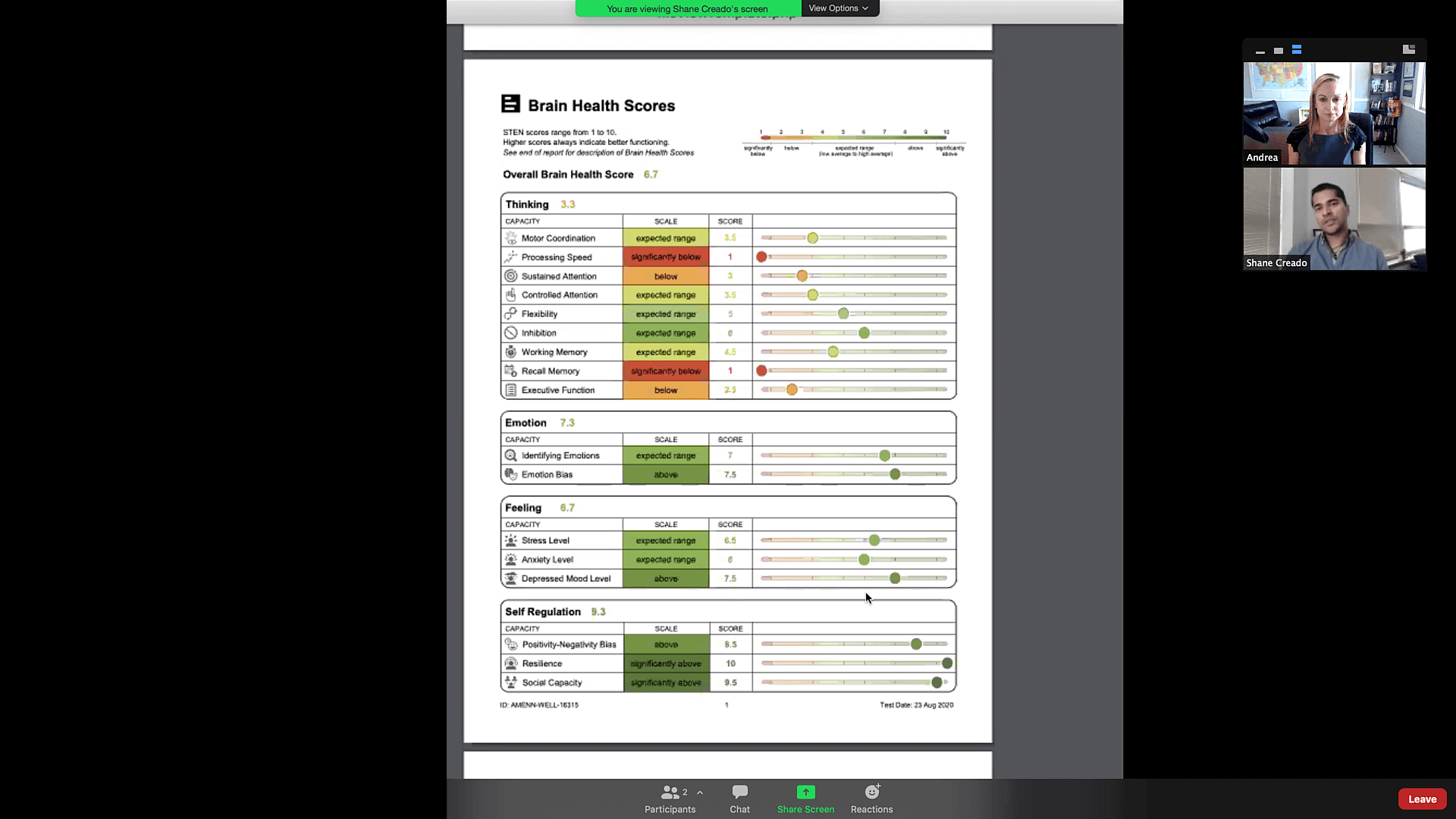Thursday Apr 27, 2023
Brain Fact Friday on ”Building Resiliency, Grit and Mental Toughness”
Enthusiasm is common. Endurance is rare.” ― Angela Duckworth
On today’s Episode #286 we will cover:
✔ A review of EP126 on building resilience (what we covered back in April 2021).
✔ A deeper look at what resilience is, with an evidence-based strategy we can all use TODAY if we are ready, to build up our own reservoirs of resiliency to better handle our life and work stressors.
✔ Tools for Measuring Resiliency.
✔ Checks for Resiliency.
✔ A Resiliency Challenge at the End to See if We Can All Push Ourselves to Try Something New to Build Resilience, Grit, Mental Toughness, and Our Ability to Use Our Head When We Need it the Most.

I needed to write this episode this week because it was just in time for me to try something new to build up my own levels of resiliency!! I hope you enjoy these ideas.
And with that introduction, I want to welcome you back to Season 9 of The Neuroscience Meets Social and Emotional Learning Podcast, where we cover the science-based evidence behind social and emotional learning (for schools) and emotional intelligence training (in the workplace) with tools, ideas and strategies that we can all use for immediate results, with our brain in mind. I’m Andrea Samadi, an author, and an educator with a passion for learning and launched this podcast to share how the understanding of our complex brain transfers into our everyday life and results. Each concept we cover here I’m hoping will help you, wherever you might be listening to this podcast in the world, just as much as these ideas are helping me personally and professionally.
For today’s episode #286, we’re staying in line with our season theme of “Going Back to the Basics to Build a Stronger, More Resilient 2.0 Version of Ourselves” which was an intention I set at the very start of the year on EP268[i] where we talked about prioritizing mental health in 2023 with a focus on self-awareness and resiliency.

A Review of Horacio Sanchez’s Definition of Resiliency:
This topic goes back with our interview with Horacio Sanchez who I was just speaking about this week because he was presenting at a Science of Reading Event, and many of us were talking about where our understanding of the brain and learning first began, with Horacio’s work at the center. He was introduced to me in our very FIRST interview EP3[ii] with Ron Hall from Valley Day School who shared that his connection of the brain and learning first began with Horacio years ago, while attending a conference where he was conducting a training session.
When we spoke with Horacio on EP74[iii] he explained resiliency as “a collection of protective risk factors that you have in your life” and that there are some factors we are born with, and others come in through childhood, family, school, life events and social experiences.
Horacio reminds us that “if you have little risk, it takes less to be resilient. But—if you have a lot of risk, it takes a lot more protective factors to offset the scale.” This is why two people can possibly respond in two completely different ways after a traumatic experience. One person walks away, dusts themselves off, and recovers quickly, (they had more reservoirs of resilience to tap into) while the other has a completely different outcome, and needs more assistance to get back on track.
With resiliency, we can overcome adversity or difficulty and have good outcomes in our life, but you can see why not everyone is born with exactly the same protective factors needed, so we don’t all have the same levels of resiliency. Horacio mentioned that “25% of the population are naturally resilient” and his work focuses on instilling this trait in those who are not naturally resilient due to the number of risk factors associated to them. To this day, he continues with this work, flying around the country, helping our next generation of students to become more resilient.
While researching for this episode, I wondered what I could add to help us to all become more resilient in addition to Horacio’s work. I looked at what Dr. Andrew Huberman had to say about resiliency with his most recent episode with a retired Navy Seals officer and author of multiple books on effective leadership, team-work, self-discipline and mindset, Jocko Willink.[iv] I listened this episode that covered a wide variety of topics, and they got into a discussion of building resilience by doing something that makes them uncomfortable every week. Something like a cold water plunge where you’d rather be sleeping in your warm bed, than doing something that Dr. Huberman would say was uncomfortable, or “like a splinter.”
Retired Navy Seals Officer Jocko Willick said that “You develop your legs by doing squats, and you develop resiliency by doing things that make you tougher” but on today’s episode, I want us to think deeply about this because there’s more to building resiliency than just doing what makes us stronger and tougher. What makes YOU tougher, might not make me tougher, (if we think about Horacio’s work on resiliency and how we are all different with these risk factors). If we are truly going to build resilience, we have to be prepared to try new things that push us past where we have been before and each person will have different thresholds and experiences.
MEDICAL DISCLAIMER: Remember that I am not a medical doctor, and that if you are going to try anything new, to always consult a medical doctor first. Today I will share ideas and strategies that I have used myself, while looking at what the most current research says, but will always remind listeners to never try anything new without first consulting your own doctor.
This leads me to look closer at cold immersion[v], an evidence-based strategy that has been shown to build resilience to stress, reduce pain in the body, improve circulation, stimulate weight loss and decrease fatigue, but over time, the research shows that your body becomes “habituated” to this practice. As for the proper dosing for this strategy, I know that Dr. Andrew Huberman suggests “progressing gradually”[vi] while Dr. Mike Tipton, a professor of human and applied physiology at the University of Portsmouth in the UK who studies the body’s reaction to extreme environments, adds that “researchers still don’t know the best way to reap the mental health benefits of cold water, or the minimum dose required” and says that “a little bit is good for you, but too much is not.”[vii]
While writing this episode, I had to think about what I do to build resilience. I always thought that exercise was my solution to every problem, but if I think about it, these runs thought the beautiful mountain tops in Arizona are NOT like a “splinter” for me, like Dr. Huberman’s mentioned. I know exercise is making me physically stronger, improving my mental health, (and solving all the other problems we know exercise solves) but now I wonder, am I doing anything on a weekly basis that makes me tougher, challenging my mind to overcome daily stress? Not according to Dr. Huberman’s definition.
- What is like a splinter for me to do?
- Am I really doing something I’d rather not be doing every week?
There might have been a time when waking up early to exercise was a “splinter” or maybe most days in the winter here, it’s not easy to leave a warm bed when it’s 40 or 50 degrees outside, so I can see where exercise could possibly help to build a stronger, more resilient version of myself.
ARE YOU BUILDING YOUR RESILIENCY MUSCLES?
- What about you?
- What is your splinter that builds your capacity (mentally and physically)?
If we don’t think about this one, we could fall into the trap of thinking we are building resilience when we really aren’t. Or getting comfortable with what might have worked in the past, and not trying anything new.
This made me think back to having my brain scanned at Dr. Amen’s Clinics and I had my review of the scan with Dr. Shane Creado, on EP 84.[viii] I remember that while he mentioned some areas of improvement, he did notice that my resilience levels were higher than many of the elite athletes that he’s tested, and I wondered where this came from. The only thing I’ve done consistently over the years that at times has felt challenging is with health (exercise, nutrition). It was evident with this brain scan that my sleep has always been a weak link but doing certain things the right way has got me this far. Now I wonder, what else could I do to build a stronger, more resilient version of myself?

Deliberate Cold Exposure to Build Resiliency and Mental Toughness
Then I thought back to when Dr. Huberman suggested deliberate cold exposure[ix] as a protocol to build mental and physical resilience, and wondered why I hadn’t tried it yet. Cold exposure isn’t something that I’m excited about (living in Arizona, my friends from snowy climates joke with me when I tell them “it’s freezing here” in the desert in the winter, and I get this skeptical look that it can’t be as cold as where they are.
What caught my attention on Dr. Huberman’s Using Deliberate Cold Exposure for Health and Performance[x] episode was that he said this practice “systematically builds up resilience.” He went on to say that “it’s an opportunity to deliberately stress our body and because it’s deliberate we can learn to maintain mental clarity, we can learn to maintain mental calm, while our body is in a state of stress.”

This is exactly what I was looking for, but of course I listened to this episode when it first came out over a year ago, and thought “there’s no way I’m ever doing that” until today, when I started DAY 1 of deliberate cold exposure, to see if I notice a difference with my ability to better handle daily stress.
Dr. Huberman explains the science behind this example extremely well, by saying that when we feel stressed in life (with our work, our relationship, or anything else that comes across our phones that in the moment makes us want to react in a way that we know we shouldn’t) that norepinephrine and epinephrine build up in the body. This is similar to what happens to our body when we deliberately expose it to cold (whether through a shower, immersion, or from going outside into the cold). He says that this systematically builds up our resilience.
So of course, I’m taking notes about how to implement this and this morning I took my first ever cold shower using Dr. Huberman’s protocol.
- Have you tried deliberate cold exposure?
- Did you notice any benefits?
I followed these steps that he suggested for a shower:
STEP 1: Pick a temperature that’s uncomfortable.
STEP 2: Get in for a certain duration of time (start with 1 minute and work your way up to 3 minutes).
STEP 3: Get out.
How Does This Build Resiliency?
Remember, this experience has got to be like a “splinter” to build resiliency, and you will release those 2 chemicals (epinephrine and norepinephrine) that are the same chemicals that flood your brain and body during stress. The longer you can function with a clear mind with these chemicals flooding your brain, the more resilient to stress you will become.
This is how resilience is built. I thought this was brilliant, and it got even better when he went on to explain how he pushes himself to stay in the cold longer, building up more resilience. He said that he “visualizes walls” so just getting into the shower is WALL 1. Then he feels ok until he thinks, “ok, it’s time to get out” and if he can stay in, let’s say go past minute 1 to minute 2, he’s got over WALL 2. Then he visualizes WALL 3 off in the distance, and when arrives at that wall, he begins to use his interoceptive awareness and think about how he’s really feeling. Can he stay in longer? Can he think clearly? Could he stay in 10 more seconds? If he can, he’s jumped over another wall, and is standing at WALL 4. At the point where he’s numb, and can do nothing else, he gets out, and knows he pushed it hard with this exercise.
I thought it was such a great example that I tried it myself, and was able to get to WALL 1 (getting into a cold shower), WALL 2 (pushed myself past 1 minutes and 30 seconds to 3 minutes) and WALL 3 (thought about how I felt, and how clearly I could think). This was enough for DAY 1, but this is going to be something I do at least 3 times a week moving forward.
Other Ways to Build Resiliency?
Another example I can think of would be strength training (and particular pushing past 20 reps to 25). My trainer used to always tell me to cheat when I’m working out on my own. He’d never let me get away with this. Now I know now that this is what builds my capacity for mental/physical resilience. It’s definitely a splinter for me, but YOU might love pushing past reps when you’re tired, while I dread it. This is just like you might dread running up and down a mountain, while I love it. We will all be different here.
REVIEW AND CONCLUSION:
To review and conclude this week’s EPISODE on a Deeper Dive into Building Resiliency, I challenge you to look at what you are doing, and see if you can identify where your “splinters” are. If you think you might be getting used to your workouts, and that they bring you joy (like they do for me) it’s time to think hard about NEW ways you can build up your capacity for more resilience.
Since we started the year with the goal to build a stronger, more resilient version of ourselves, the key to doing this is to build our immune system up by being able to better manage our levels of stress.
My hope for all of us is that as we face our challenges on a daily basis, that we push ourselves always to reach new heights that are greater than where we were yesterday. I’ll close out with a quote from Lee Ann Womack,
“I hope you never fear those mountains in the distance . Never settle for the path of least resistance”― Lee Ann Womack, I Hope You Dance
Keep your eye on overcoming challenge, and you’ll be a stronger, more resilient version of yourself by the end of the year.
See you next week!
FOLLOW ANDREA SAMADI:
YouTube Channel: https://www.youtube.com/c/AndreaSamadi
Website https://www.achieveit360.com/
LinkedIn: https://www.linkedin.com/in/samadi/
Facebook: https://www.facebook.com/Achieveit360com
Neuroscience Meets SEL Facebook Group https://www.facebook.com/groups/2975814899101697
Twitter: https://twitter.com/andreasamadi
Instagram: https://www.instagram.com/andreasamadi/
REFERENCES:
[i]Neuroscience Meets Social and Emotional Learning Podcast EPISODE #126 https://andreasamadi.podbean.com/e/brain-fact-friday-prioritizing-mental-health-in-2023-improving-self-awareness-and-resilience/
[ii]Neuroscience Meets Social and Emotional Learning Podcast EPISODE #3 https://andreasamadi.podbean.com/e/interview-with-ron-hall-valley-day-school-on-launching-your-neuroeducational-program/
[iii] Neuroscience Meets Social and Emotional Learning Podcast EPISODE #74 with Horacio Sanchez on “How to Apply Brain Science to Improve Instruction and School Climate” https://andreasamadi.podbean.com/e/leading-brain-science-and-resiliency-expert-horatio-sanchez-on-how-to-apply-brain-science-to-improve-instruction-and-school-climate/
[iv] https://hubermanlab.com/jocko-willink-how-to-become-resilient-forge-your-identity-and-lead-others/
[v] Using Cold Water Immersion to Build Stress Resilience Published May 22, 2022 https://www.meducos.com/using-cold-water-immersion-to-build-stress-resilience
[vi] Using Deliberate Cold Exposure for Health and Performance Huberman Lab #66 https://www.youtube.com/watch?v=pq6WHJzOkno
[vii] Cold Water Plunges Are Trendy. Can They Really Reduce Anxiety and Depression? Published by Chloe Williams https://www.nytimes.com/2022/02/20/well/mind/cold-water-plunge-mental-health.html
[viii] https://andreasamadi.podbean.com/e/how-a-spect-scan-can-change-your-life-part-3-with-andrea-samadi/
[ix] Using Deliberate Cold Exposure for Health and Performance Huberman Lab #66 https://www.youtube.com/watch?v=pq6WHJzOkno
[x]Using Deliberate Cold Exposure for Health and Performance Huberman Lab #66 https://hubermanlab.com/using-deliberate-cold-exposure-for-health-and-performance/
No comments yet. Be the first to say something!